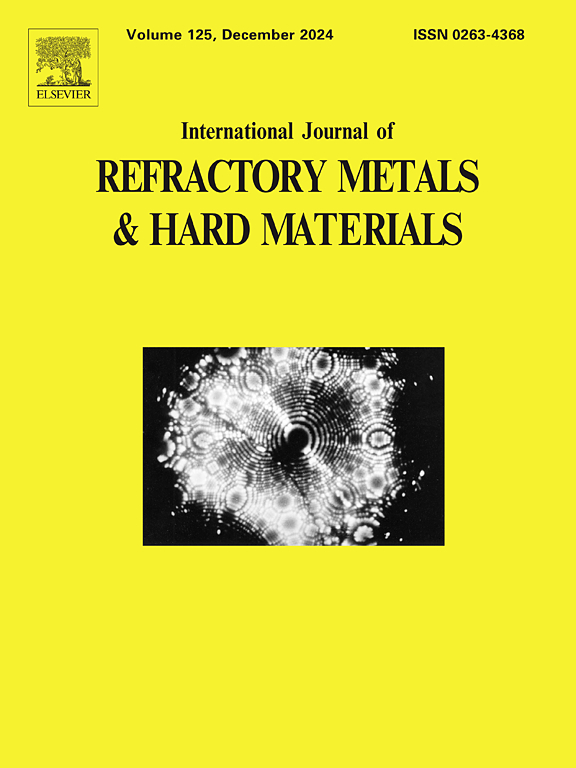Comparative study of microstructure and mechanical properties of Nb-Ti-Al alloy fabricated by as-cast and laser directed energy deposition processing
IF 4.2
2区 材料科学
Q2 MATERIALS SCIENCE, MULTIDISCIPLINARY
International Journal of Refractory Metals & Hard Materials
Pub Date : 2025-05-07
DOI:10.1016/j.ijrmhm.2025.107220
引用次数: 0
Abstract
Niobium alloy has attracted widespread attention in the aerospace industry due to its high strength, excellent weldability and formability. It is capable of producing structural thin plates and complex shaped parts by laser directed energy deposition (LDED). In this work, single-track Nb-37Ti-5Al samples were fabricated by LDED to optimize of processing parameters, then multi-track Nb-37Ti-5Al was prepared. The as cast Nb-37Ti-5Al was prepared to compare its mechanical properties with LDEDed alloy, the effect of oxygen content on the fracture behavior was revealed. LDEDed alloy has high strength and low ductility, which is mainly due to the high oxygen content in powder feedstocks. The stability, elastic properties, electronic structure of pure niobium (Nb), niobium with dissolved oxygen (Nb(O)), Nb-37Ti-5Al and Nb-37Ti-5Al with dissolved oxygen (Nb-37Ti-5Al(O)) were investigated using first principles calculation. Interstitial oxygen atom causes electron rearrangement of niobium, titanium and aluminum, which promotes the formation of ionic bonds and covalency bonds. This work provides new insight regarding the correlation between the interaction of oxygen and metallic elements at atomic-level and mechanical behavior.
铸态与激光定向能沉积Nb-Ti-Al合金组织与力学性能的比较研究
铌合金以其高强度、优良的可焊性和成形性在航空航天领域受到广泛关注。利用激光定向能沉积技术(LDED)可以生产结构薄板和形状复杂的零件。通过优化工艺参数,采用led光致发光技术制备了单轨道Nb-37Ti-5Al样品,然后制备了多轨道Nb-37Ti-5Al样品。制备了铸态Nb-37Ti-5Al,比较了其与LDEDed合金的力学性能,揭示了氧含量对其断裂行为的影响。LDEDed合金具有高强度和低延展性,这主要是由于粉末原料中氧含量高。采用第一性原理计算方法研究了纯铌(Nb)、铌带溶解氧(Nb(O))、铌- 37ti - 5al和铌- 37ti - 5al带溶解氧(Nb- 37ti - 5al (O))的稳定性、弹性性能和电子结构。间隙氧原子引起铌、钛和铝的电子重排,促进离子键和共价键的形成。这项工作为氧与金属元素在原子水平上的相互作用与力学行为之间的关系提供了新的见解。
本文章由计算机程序翻译,如有差异,请以英文原文为准。
求助全文
约1分钟内获得全文
求助全文
来源期刊
CiteScore
7.00
自引率
13.90%
发文量
236
审稿时长
35 days
期刊介绍:
The International Journal of Refractory Metals and Hard Materials (IJRMHM) publishes original research articles concerned with all aspects of refractory metals and hard materials. Refractory metals are defined as metals with melting points higher than 1800 °C. These are tungsten, molybdenum, chromium, tantalum, niobium, hafnium, and rhenium, as well as many compounds and alloys based thereupon. Hard materials that are included in the scope of this journal are defined as materials with hardness values higher than 1000 kg/mm2, primarily intended for applications as manufacturing tools or wear resistant components in mechanical systems. Thus they encompass carbides, nitrides and borides of metals, and related compounds. A special focus of this journal is put on the family of hardmetals, which is also known as cemented tungsten carbide, and cermets which are based on titanium carbide and carbonitrides with or without a metal binder. Ceramics and superhard materials including diamond and cubic boron nitride may also be accepted provided the subject material is presented as hard materials as defined above.

 求助内容:
求助内容: 应助结果提醒方式:
应助结果提醒方式:


